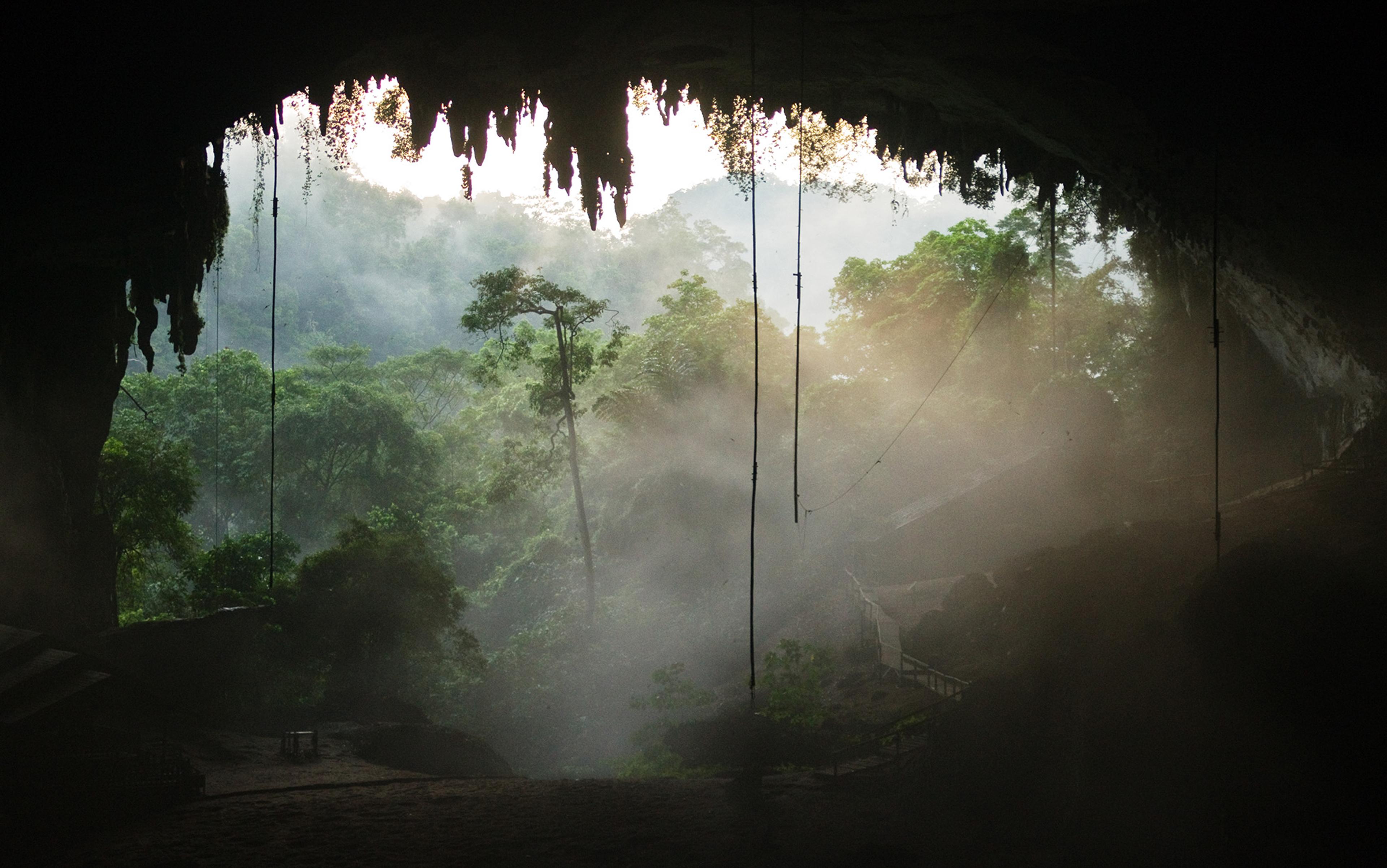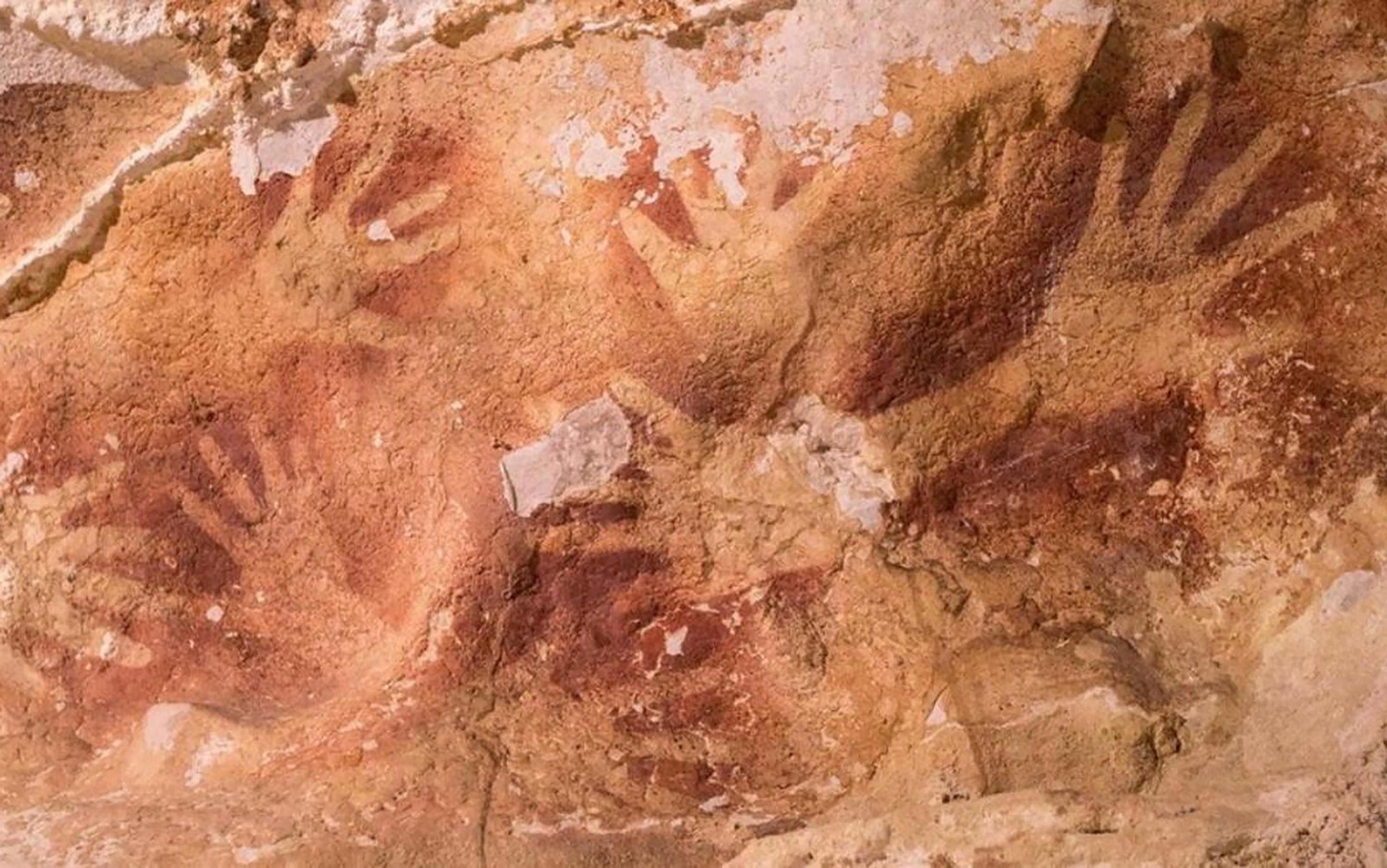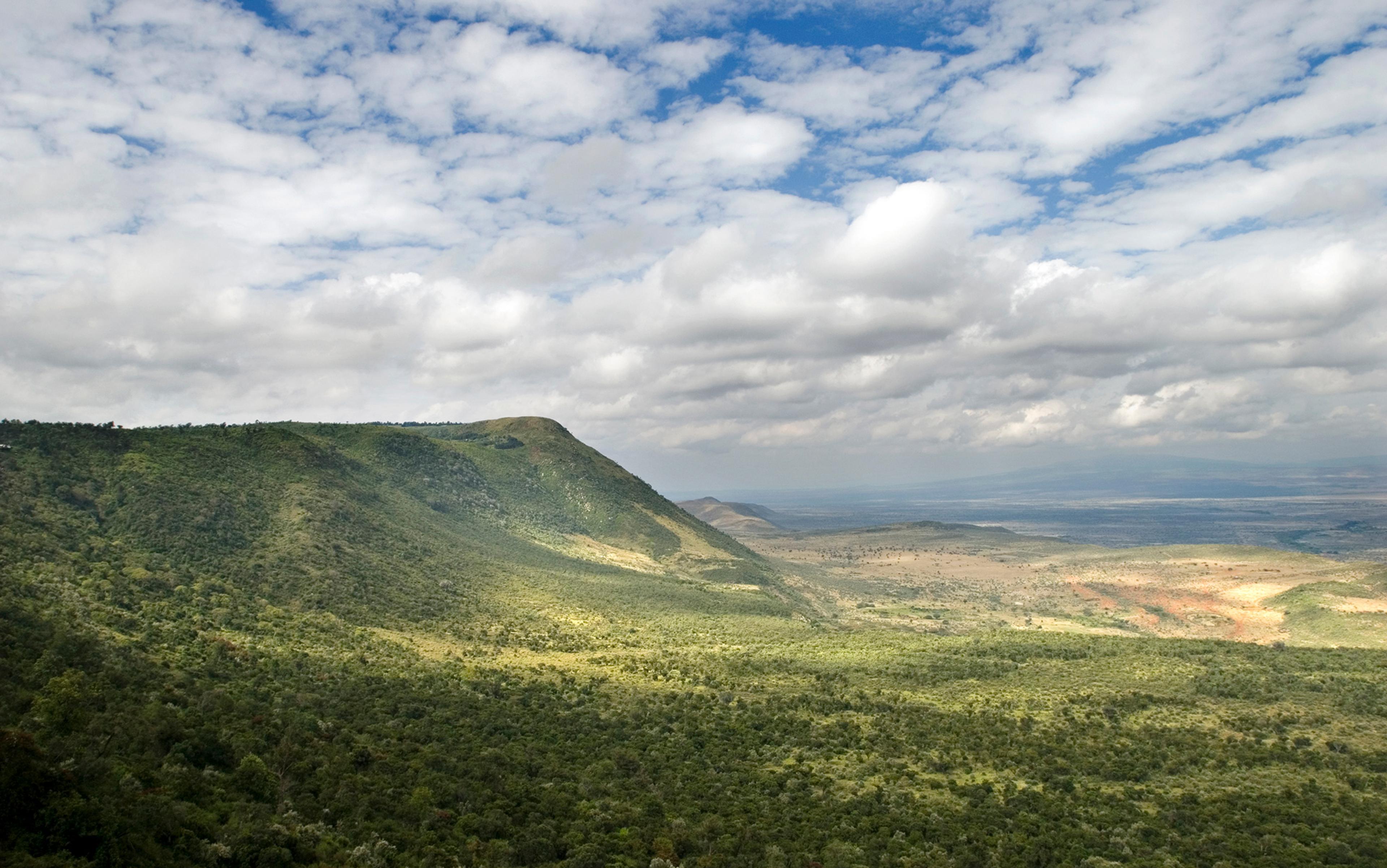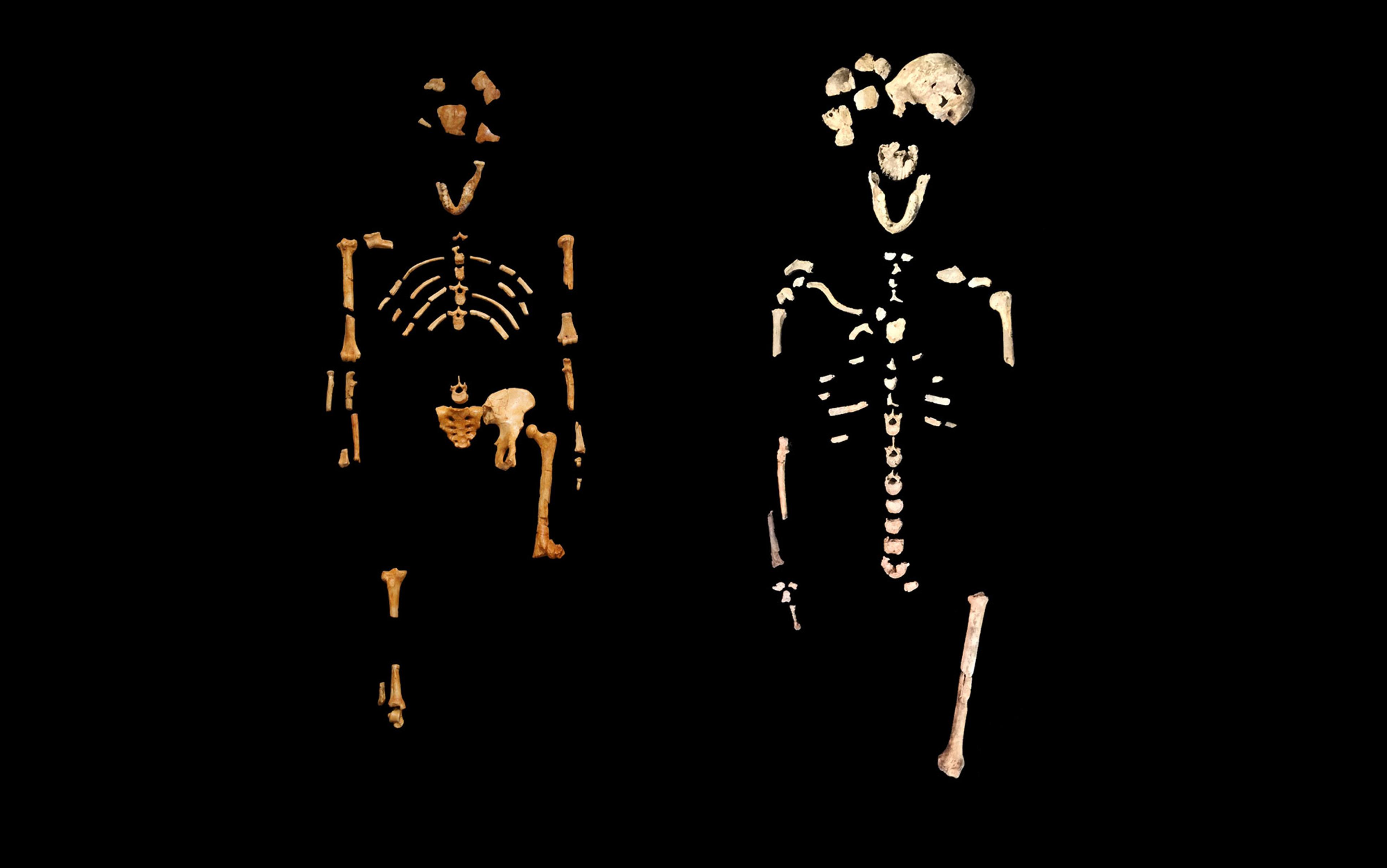In a sweltering tropical rainforest on an island in the middle of the Indian Ocean, I started to appreciate why archaeologists and anthropologists had long ignored ‘jungles’ in their search for humanity’s origins. The mosquitoes, leeches, harsh terrain and difficult footing were bad enough, but now a summer monsoon downpour was rapidly approaching. As we slogged on under a canopy of green, the forest grew quiet. The usual chattering life had been smart enough to seek shelter, leaving us alone to face the monsoon rains.
It was the summer of 2014, and I was trudging through a tropical rainforest in Sri Lanka with my close friend and colleague, the archaeologist Oshan Wedage. We’d come here to do archaeological fieldwork, to look for traces of past human activity, and to challenge prevailing narratives about our species’ evolution. We’d come for answers to a controversial question: what if our distant ancestors had chosen to live in humid, insect-ridden forests like this one?
This is a controversial question because, since Charles Darwin, many scholars have avoided tropical forests and focused instead on dry ‘savannahs’ as the key to early hominin evolution in Africa. There are many reasons for this, including the groundbreaking fossil discovery of ‘Lucy’ in Ethiopia, the multi-year campaigns of the British-Kenyan archaeologists Louis and Mary Leakey in eastern Africa, and the analysis of the earliest stone tools, which were found in Kenya and later determined to be 3.3 million years old. The contexts of these remarkable finds all seemed to suggest that it was out in the open – not in dense rainforests – that our hominin ancestors apparently first became increasingly upright, freed up their hands for experimentation with tools, and hunted large game to fuel their growing brains. This focus on open spaces, with an additional consideration of coastal habitats, has not only dominated the study of our hominin ancestors but also the study of our own species. It has dictated how we understand our unique behavioural traits, and our incredible feats of dispersal after Homo sapiens emerged in the Middle Pleistocene, roughly between 300,000 and 200,000 years ago.
Throughout this vast span of human history, tropical forests remained the challenging habitats we ‘left behind’. But during the past few years, several truly remarkable sites and findings have catapulted tropical forests to the centre of key debates in human evolution. In fact, it was one of those sites, a cave called Batadomba-lena – a Sinhalese name that literally means ‘the cave surrounded by bamboo and domba trees’ – that slowly emerged in the sodden distance as a source of shelter from monsoon rains back in 2014. What was found in that cave, and many other recently explored archaeological sites around the world, confounds accepted narratives about Homo sapiens and its ancestors. It forces us to ask new questions of our origins. Does the hominin story in fact begin in tropical forests? And, if so, does this change how we understand ourselves as a species?
For the past two centuries, the most widely accepted account of our origins is a story that begins in the open savannahs of Africa. The ‘savannah hypothesis’, as applied in palaeoanthropology and archaeology, refers to the idea that early processes of human evolution were characterised by hominins in Africa leaving forests and woodlands, and heading for more open grasslands. The most common formulation of this argument posits that climate change during the Middle and Late Miocene, which intensified around 8 million years ago, led to a retreat of tropical forests and the expansion of these grasslands, which forced our ancestors to step onto the ‘savannah’ and make a living in a new, open world. Such ideas were expressed as early as 1809 in the writings of Jean-Baptiste Lamarck, and later in Darwin’s The Descent of Man (1871). But it is Raymond Dart who is often credited with thrusting ‘savannahs’ to the top of the palaeoanthropological research agenda. In 1925, he wrote about his famous ‘Taung child’ discovery in South Africa – a fossilised skull from the hominin species Australopithecus africanus, which we now know lived from 3.7 to around 3 to 2 million years ago – and argued that adaptations to harsh, arid grassland settings were central to hominin evolution.
As more remarkable fossil findings emerged from volcanic landscapes in eastern Africa during the 20th century, these early variations of the ‘savannah hypothesis’ continued to influence anthropological and archaeological discourse. The most well known of these is probably ‘Lucy’, named after the Beatles’ song ‘Lucy in the Sky with Diamonds’ (1967), which was playing in the field camp after her discovery. This remarkably complete hominin skeleton of the species Australopithecus afarensis was excavated in Ethiopia’s Afar desert. Dating to roughly 3.2 million years ago, she is just one member of a sequence of increasingly upright, specialised hominin bipeds. These hominins seem to have emerged in environments that gradually became more open around 5 to 2 million years ago. These bipeds include the hominin Homo habilis found in Oldupai (formerly Olduvai) Gorge in Tanzania, which first emerged around 2.4 million years ago and was long assumed, prior to the discoveries mentioned above, to have produced the first stone tools in the archaeological record.
Further support for the ‘savannah hypothesis’ came from the chemical analysis of preserved teeth from African hominins, which revealed a growing reliance on food expected to have come from grasslands. This research was pioneered in the 1980s by my former supervisor, the South African archaeological scientist and geochemist Julia Lee-Thorp. She was the first to study teeth in early hominin fossils using stable carbon isotope analysis, which allowed her to distinguish between diets focused on woody and shrubby habitats, and those centred on tropical grasslands. The comprehensive dataset of hominins that has been produced using these methods – spanning Ardipithecus ramidus (aka ‘Ardi’) from around 5 million years ago, to our genus, Homo, 3 to 2 million years ago – documents a shift towards the use of resources from open habitats like grasslands. But there is some significant variability in resource use between individuals of the same species: the exact resources these early hominins consumed, reflected in the chemistry of their fossilised teeth, is up for debate.
Tropical forests remained an important source of food, and perhaps offered protection from predators
During the past few decades, however, a few leafy spanners have been thrown in the works of the ‘savannah’ narrative. The earliest hominins, dating from around 7 to 5 million years ago, show that our ancestors’ first experiments with bipedalism occurred in mixed forest and woodland settings. (Among the Great Apes alive today, the orangutan uses bipedalism the most frequently, doing so as it reaches for sugar-rich fruits high up in the canopy.) Not only that, but analyses of fossil hominin skeletons dating between 5 to 2 million years ago, including that of ‘Lucy’ and those of our own genus, show that many of them still had arms, shoulders and hands adapted to climbing (a skill necessary for life in the forest) even as their interactions with terra firma increased.
Environmental reconstructions have also introduced complexity to the classic ‘savannah’ narrative. Researchers once assumed that bipedalism was driven by an expansion of grasslands. It was believed that, as those habitats spread, hominin physiology changed as it adapted to a new life on the open savannah. For this theory to hold water, these landscapes would have needed to expand roughly at the same time that physiological changes appear in hominin fossils. However, sediments from deep-sea marine cores show that ancient tropical African grasslands had already expanded by 10 million years ago, long before the first hominins took their first bipedal strides around 7 to 5 million years ago.
With this evidence, the assumed close relationship between grassland proliferation and the first branching of our hominin family tree seems to break down. Additionally, environmental information from the fossil remains of plants and animals, as well as chemical studies of sediments on land, in lakes and in the ocean, show that many sites where hominins (and their tools) were found were not entirely open grasslands but once had stable tree cover. Today, the term ‘savannah’ also actually encompasses a range of micro-habitats. Indeed, depending on local rainfall and geology, you can find trees and even patches of forest in contemporary African savannahs.
Although open environments played a major role in early human evolution, tropical forests and forest patches still provided a significant backdrop for our first hominin ancestors as they emerged in the tropics of Africa. They likely took their first tentative steps as bipedal mammals in tropical forests, or at least mixed forest habitats. Right until the appearance of the genus Homo, between 3 to 2 million years ago, tropical forests and woodlands remained an important source of food, and perhaps offered protection from predators. Given that most of the hominin fossils from this deep time period still come from eastern and southern Africa, it is also possible that in the years to come new discoveries in the continent’s warm, wet centre and its west will yield further insights into our tropical origins.
The Pleistocene, which began about 2.58 million years ago and ended around 12,000 years ago, saw hominin horizons extend beyond Africa. From 1.8 million years ago, stone tools turn up in the cool climes of Dmanisi in Georgia and later in wet and windy Norfolk in the United Kingdom. Finds of crafted ‘Acheulean’ hand-axes act as ‘breadcrumbs’ for the extension of our genus from Africa into South Asia, the Middle East and Europe between 1.7 and 1 million years ago. Homo erectus was a key hominin player in this expansion. This hominin emerged in Africa around 2 million years ago and, as the name suggests, specialised in walking upright. Discoveries of stone tools and butchered animal carcasses suggest it also focused on hunting and scavenging meat from animals, including elephants and antelope, and preferred open grassland environments.
With this meaty menu in mind, the first expansions of our ancestors beyond Africa have often been associated with periods of climate change that would have resulted in the extension of grassland ‘corridors’ out of Africa. Extending across the Middle East, Europe and Asia, these habitats supposedly provided open conveyor belts for the large animals that had become important sources of food for hominins. According to this theory, our ancestors followed their prey out of the continent. But what happened when these early hominin navigators reached tropical forest realms beyond Africa? We know that Homo erectus had made it to Java in Indonesia 1.5 million years ago. Was it met by a wall of dense tropical rainforest, or did it benefit from the penetration of grassland corridors down towards the equator?
Nicknamed ‘the Hobbit’, its small stature has been considered evidence of its adaptation to tropical forests
Recent evidence suggests that tropical forest environments shrank at the time of Homo erectus’ arrival in Southeast Asia – a change that may have led to the demise of the forest-adapted Gigantopithecus, the largest ape to have ever lived. Homo erectus’ appearance in tropical Southeast Asia coincides with a big shift in the wider animal community, including the expansion of the ancient elephant-like Stegodon. Does the shrinking of forests and the changing of animal communities suggest that the ‘savannah’ played a prominent role in this hominin’s settlement of the Asian tropics? The evidence seems to suggest this, but caution is required. The plants and animals found alongside Homo erectus and its stone tools tend to indicate a mixed environment of marshy settings, grasslands, woodlands and rainforest edges, rather than a homogeneous ‘savannah’. While tropical forests were certainly present on the Southeast Asian landscape when Homo erectus arrived, future research is needed to clarify the specific ecological adaptations of this roaming hominin.
Startling fossil and archaeological finds in the past half-decade have shown that Homo erectus was not the only hominin to make its home in tropical Southeast Asia during the Pleistocene. In 2004, researchers discovered a new hominin species, Homo floresiensis, on the island of Flores in Indonesia. Nicknamed ‘the Hobbit’, its small stature has been considered as possible evidence of its adaptation to tropical forests. This claim follows Bergmann’s rule, which states that smaller species are found in warmer areas because a higher surface-area-to-volume ratio enables them to dissipate more heat. Another hominin species, the Denisovans, may have also left some traces in the tropics of this region. There’s no formal name for Denisovans yet, due to the lack of a complete fossil record, but it’s suggested that this species interbred with Homo sapiens in Southeast Asia or Oceania. Denisovans were first identified as a distinct lineage based on ancient DNA from a fingerbone in a Siberian cave (though a study from early 2022 has apparently revealed its presence at a cave site in tropical Laos). Finally, in 2019, a new species, Homo luzonensis, was recorded in the Philippines, adding to the diverse tropical cast of Southeast Asian hominins.
Tropical forests have provided the modern setting for these remarkable findings and dramatically altered our understanding of human evolution. However, the exact relationship of each of these hominin species to tropical forests in the past remains hotly debated. Direct evidence for their use of tropical forest plants or animals is scarce and, even in the case of ‘the Hobbit’, mixed grassland and forest habitats seem to have been much more important than a particular reliance on one or the other, with its diminutive stature perhaps linked to island isolation rather than a response to warm temperatures. What’s certain is that roughly 300,000 to 200,000 years ago one hominin species emerged that could inhabit and use tropical forests more effectively than any of those that went before: Homo sapiens.
Our species has often been considered the final descendant in a long line of hominins that evolved by adapting to open grasslands (and the mammalian prey and predators that inhabited them). When not thought of in terms of grasslands, our origin story is also commonly understood by palaeoanthropologists and archaeologists in terms of adaptations to coastal environments. At cave sites on the southern and northern coasts of Africa, personal ornaments, art and complex technologies have been found suggesting that, in addition to grasslands, our species may have adapted to use protein-rich marine resources. Unlike grasslands or coasts, tropical forests have been seen as comparatively unattractive ‘barriers’ to Homo sapiens, due to their small, difficult-to-catch prey, poisonous plants and tropical diseases. But the idea that tropical forests were avoided by Late Pleistocene humans is no longer tenable.
There is growing evidence for the role of tropical forests in our species’ evolution and dispersal, and Batadomba-lena cave, where we started this essay, is a key site. This cave has rewritten tropical forests into European and North American accounts of human history. Over the course of the past two decades, tropical sites like Batadomba-lena (alongside nearby caves Fa-Hien Lena and Kitulgala Beli-lena) have produced some of the most important archaeological and anthropological insights into the evolution, behaviour and capabilities of early Homo sapiens. These caves in Sri Lanka have demonstrated that the first humans who arrived on this island did not head straight for the coasts or the open grasslands. Instead, the first human traces and fossils found here, dating back 45,000 years, come from dense tropical rainforests. Well-preserved fossils and artefacts in these cool cave environments have shown that humans hunted monkeys and giant squirrels with bow and arrow technology. They used carbohydrate-rich nuts and nearby freshwater streams. And they may even have made clothes to protect themselves – not from the cold, but from a myriad of vampiric pests.
Humans were not only able to use tropical forests when they first arrived in Sri Lanka, they actively chose to. This is something increasingly witnessed at archaeological sites across the tropics. Archaeological findings in Africa, where our evolutionary story begins, are raising suspicions that humans may have already been well at home in the forests of Central and Western Africa as early as 300,000 to 200,000 years ago. A genetic study published in 2021 has further highlighted the likelihood that our species emerged from interactions between populations living in a diversity of environments across the African continent. One of them, of course, being tropical forests.
Tropical forests are home to the oldest cave art ever recorded
There is clear evidence on the tropical coast of Kenya that, by 78,000 years ago, Pleistocene humans were interacting closely with these forests. In 2021, a Kenyan cave called Panga ya Saidi shot to fame as the site of the earliest human burial in Africa. But that’s not the only reason this site is important. Detailed reconstructions of past environments from plant and animal remains, as well as biochemical methods, show that humans at this site made use of grasslands and tropical forests. Also, despite Panga ya Saidi being on the coast, there is limited evidence that marine critters were used as food sources during the early periods when it was occupied by humans. This pattern is repeated across the diverse tropical forests of the Pleistocene, highlighting that flexibility and adaptability characterise what it means to be human, rather than any focus on a single specific habitat.
On the island of Sumatra, recent archaeological investigations have pushed back human arrival in Southeast Asia to around 70,000 years ago – a remarkable 30,000 years earlier than previous estimates. In Borneo, evidence from the Niah Caves shows that humans were managing forests with fire and processing toxic plants around 45,000 years ago. Around almost the same time, humans in Oceania used starch-rich tree nuts in the montane tropical forests of New Guinea. In the wet tropics of Queensland in Australia, a peak in charcoal found in lake sediments from around 45,000 years ago has also been linked to the arrival of humans (though this hasn’t yet been confirmed by unearthed artefacts in the region). In South America, between 14,000 and 12,000 years ago, humans colonised tropical forests, from the high-altitude Andes down to the Amazon basin where they painted remarkable images of now-extinct megafauna on the walls of rock shelters.
These rock art images from the Colombian Amazon highlight how tropical forests were a key part of the aesthetic world of early human populations. Based on well-known cave drawings in Lascaux and Altamira in western Europe, we often associate early art with animals that inhabited grassy steppes: big cats, wild oxen and horses. However, at Serranía de la Lindosa in Colombia, humans were painting giant sloths and mastodons, which have been found in tropical forest settings across the region. In 2021, amazing discoveries at a Sulawesi limestone cave called ‘Leang Bulu’ Sipong 4’ found that tropical forests are home to the oldest cave art ever recorded, dating to at least 45,500 years ago. These drawings show figures hunting wild pigs – animals known to enjoy forest habitats. Tropical forests were not just a key part of our species’ experimentation with different ecologies, but also cultural materials and perhaps also an important setting for the emergence of storytelling.
By the time the Pleistocene ended, around 12,000 years ago, our species had occupied and utilised practically every type of tropical forest on Earth. These environments may provide some clues as to what makes Homo sapiens unique among hominins. In Southeast Asia, recent discoveries show that Homo erectus persisted right down to 100,000 years ago and Homo floresiensis down to 50,000 years ago. This makes Homo erectus’ time on the planet far longer than our own to date. Around that time, dense tropical rainforests and the fauna that still characterise these habitats today, such as orangutans, expanded across the region. This seemed to place significant and unique pressures on the diverse cast of hominins inhabiting Southeast Asia at the time. Only one would survive: us.
It was in Batadomba-lena where I first began to study our species’ interaction with tropical forests, investigating the chemistry of ancient human teeth to show that the earliest occupants of Sri Lanka practised a full-time, forested livelihood. Since that fieldwork in 2014, it has become clear that these environments continue to provide groundbreaking insights into the origins, dispersals and adaptations of our species and its ancestors. Not only that, but these ‘extreme’ environments provide us with action-packed snapshots into some of Homo sapiens’ greatest successes. In tropical forests we can explore how, by the end of the Pleistocene, we became the first hominin to colonise most of the world’s varied environments, and then became the last hominin left.
Of course, other habitats are critical to the human story as well. There is now evidence that humans were making themselves at home in deserts, high mountains, and the Arctic circle by 45,000 years ago. Evidence found in tropical forests, as well as these other places, is encouraging archaeologists and anthropologists to move away from an exclusive focus on savannahs and coasts. They’re recognising that studying a plethora of Pleistocene climates and environments might provide the best clues to our origin story – and to what it means to be human.
Indigenous peoples have long emphasised the human history of tropical forests and their cultural heritage
It is also in tropical forests that we find some of the earliest indications of humans manipulating plants, animals and even whole habitats. In New Guinea and Borneo, and perhaps Australia, there is evidence that humans were deliberately managing tropical forests using fire around 45,000 years ago, promoting plant growth and wild-animal numbers. In the Bismarck Archipelago, just off the coast of New Guinea, there is even evidence that, by 20,000 years ago, humans were deliberately moving tropical forest animals from one island to another, bolstering their sources of protein. These tropical interventions in the natural world provide early signs of the emergence of cultivation, herding and food production that would leave lasting marks on tropical forests, and other landscapes, the world over.
Thanks to the array of revolutionary findings discussed above, the ‘savannah hypothesis’ is becoming increasingly unattractive in palaeoanthropological and archaeological discourse. Instead, environments such as tropical forests are playing a critical role in highlighting that climatic and environmental variability provided the setting for the grand evolutionary romp of our species and its hominin ancestors. Climate changes during the Miocene and the subsequent expansion of African grasslands were important players in hominin evolution and behavioural change, and savannahs and coasts were undoubtedly used by Homo sapiens from its first emergence in Africa and during its near-global Pleistocene dispersals. Nevertheless, a raft of emerging evidence shows that it is dynamism and diversity that best characterises the past 7 million years of our history. And tropical forests are an important, once-overlooked part of this diversity.
But it would be wrong to assume that palaeontologists and archaeologists are the only ones championing this new view of our diverse past. For centuries, if not millennia, Indigenous peoples have emphasised the long human history of tropical forests and the cultural heritage locked within them, though they have often been marginalised or ignored. Along with recent archaeological and palaeoanthropological discoveries, Indigenous groups have clearly demonstrated that, as tropical forests disappear, we lose not only immense plant and animal biodiversity but also many secrets about where we come from and what makes us human.
Since the Victorian era, especially in literature and film, tropical forests have often been seen as ‘wild’ and hostile backwaters, or pristine and ‘natural’ havens untouched by humans. Yet, we now see that vibrant tropical forests provided the evolutionary cradle for the earliest hominins. They accompanied the genus Homo out of Africa (in some form). And they give us critical insights into the unique adaptive capacities of our species. Early artistic musings found in Colombia and Sulawesi also show us that tropical forests have long been a source of human creativity and cultural representation. Tropical forests are, and have always been, a key part of our remarkable human story. They have been constant companions along our journey. The challenge now is to ensure that they remain by our side during whatever comes next.






